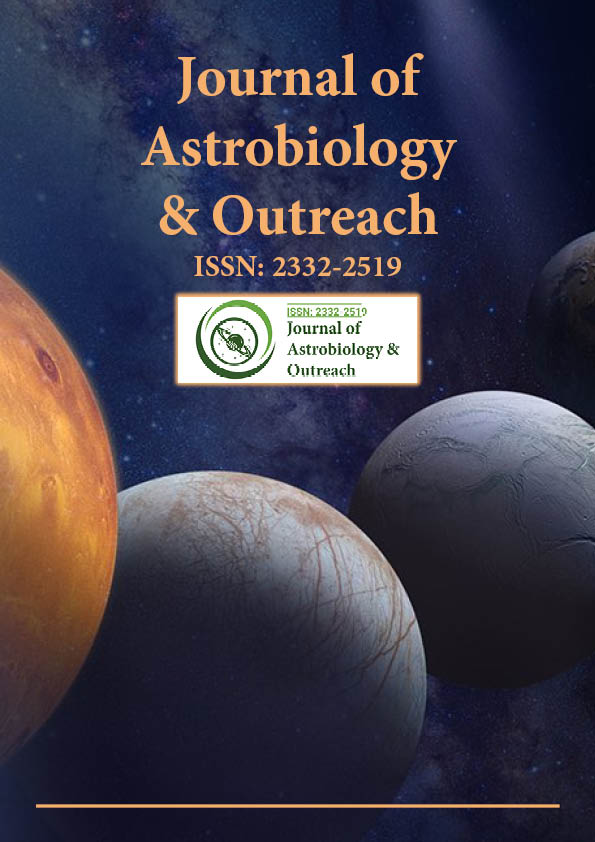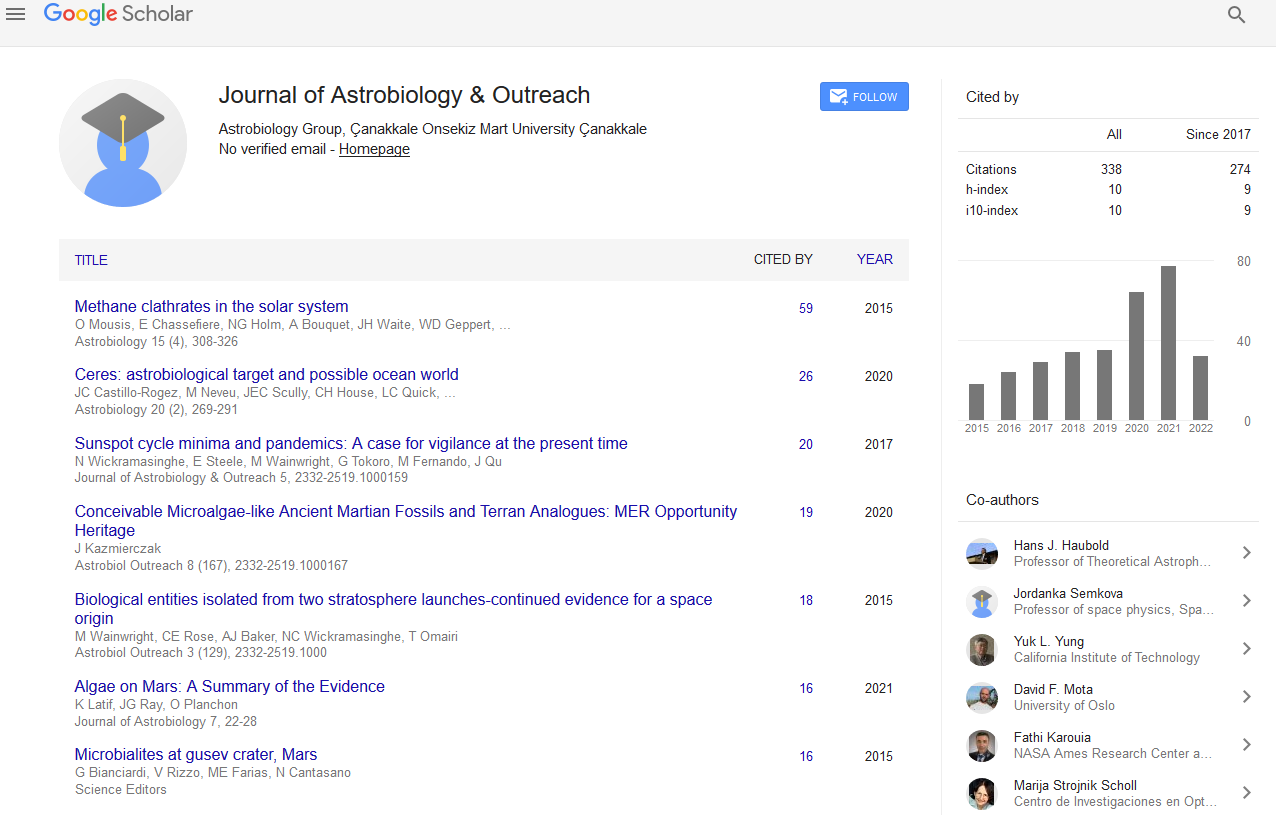Indexed In
- Open J Gate
- Academic Keys
- JournalTOCs
- RefSeek
- Hamdard University
- EBSCO A-Z
- OCLC- WorldCat
- Google Scholar
Useful Links
Share This Page
Journal Flyer

Open Access Journals
- Agri and Aquaculture
- Biochemistry
- Bioinformatics & Systems Biology
- Business & Management
- Chemistry
- Clinical Sciences
- Engineering
- Food & Nutrition
- General Science
- Genetics & Molecular Biology
- Immunology & Microbiology
- Medical Sciences
- Neuroscience & Psychology
- Nursing & Health Care
- Pharmaceutical Sciences
Opinion Article - (2024) Volume 12, Issue 3
Preserving Purity and Safety: Planetary Protection in the Mars Sample Return Mission
Anna Müller*Received: 30-Aug-2024, Manuscript No. JAO-24-27914; Editor assigned: 02-Sep-2024, Pre QC No. JAO-24-27914 (PQ); Reviewed: 16-Sep-2024, QC No. JAO-24-27914; Revised: 23-Sep-2024, Manuscript No. JAO-24-27914 (R); Published: 30-Sep-2024, DOI: 10.35248/2332-2519.24.12.355
Description
The Mars Sample Return (MSR) mission represents one of the most ambitious undertakings in space exploration. It aims to collect samples from the Martian surface and return them to Earth for in-depth analysis, providing unparalleled insights into Mars' geological history and the potential for past or present life. Central to the success of this mission is the planetary protection strategy implemented by the Earth Return Orbiter (ERO), a critical component designed to ensure the safe containment and transport of Martian material. This strategy is not only a technical necessity but also a significant ethical and scientific measure to protect Earth's biosphere and ensure the preservation of Martian sample purity.
Planetary protection refers to the policies and practices that prevent biological contamination of celestial bodies by Earth organisms (forward contamination) and protect Earth from potential extraterrestrial biohazards (backward contamination). For the MSR mission, the ERO plays a significant role in backward contamination prevention by securely transferring Mars samples collected by a lander and returned to orbit via a rocket into a containment system for transport to Earth. This process is controlled by rigorous protocols to ensure absolute containment and sterilization, minimizing the risk of unintentional release of potentially harmful material.
The planetary protection strategy also includes extensive prelaunch testing and validation of containment systems, ensuring they meet international standards. The spacecraft and its components undergo rigorous sterilization procedures and the materials used in the containment systems are chosen to withstand extreme temperatures, radiation and mechanical stresses. Additionally, the mission includes contingency plans to address any unexpected breaches or anomalies during the sample's return, underscoring the mission's commitment to safety and scientific integrity.
Beyond the technical aspects, the MSR mission’s planetary protection strategy holds ethical and societal implications. The prospect of bringing Martian material to Earth raises questions about humanity’s responsibility in handling potential extraterrestrial life forms, if any exist. While the likelihood of pathogenic microorganisms from Mars is considered low, the precautionary approach reflects a broader commitment to responsible exploration. This ethos aligns with the principles outlined in the Outer Space Treaty, which emphasizes the need to avoid harmful contamination of celestial bodies and adverse changes to Earth’s environment.
The ERO’s role in planetary protection also intersects with the broader goals of astrobiology. By ensuring the uncontaminated return of Martian samples, the mission maximizes the scientific value of the materials, allowing researchers to search for signs of ancient microbial life or other biosignatures with confidence. The preservation of these samples will help answer fundamental questions about the potential for life beyond Earth and provide a comparative framework for understanding planetary evolution.
Public outreach and engagement play a significant role in the MSR mission’s planetary protection efforts. Transparent communication about the measures taken to protect Earth and ensure the safety of the mission fosters public trust and support. Educational initiatives highlighting the meticulous planning and international collaboration involved in the ERO's design and planetary protection protocols also inspire interest in space science and the ethical considerations of interplanetary exploration.
The Mars Sample Return mission’s planetary protection strategy is not without its challenges. Balancing stringent safety measures with practical and financial constraints requires innovative engineering and careful prioritization. International collaboration adds complexity, as different space agencies contribute expertise, technologies and compliance with shared planetary protection standards. However, these challenges also highlight the mission’s significance as a global effort to explore Mars responsibly and advance scientific knowledge.
In conclusion, the planetary protection strategy of the Mars Sample Return’s Earth Return Orbiter mission embodies the intersection of scientific rigor, technological innovation and ethical responsibility. By prioritizing the safe containment and return of Martian samples, the mission protects Earth’s biosphere while preserving the integrity of the samples for meaningful scientific inquiry. The ERO’s meticulous planning and execution set a precedent for future interplanetary missions, demonstrating humanity’s capacity to explore the cosmos with care and respect for both our planet and potential extraterrestrial ecosystems. As we move closer to realizing the goal of returning Martian material to Earth, the MSR mission stands as a testament to the power of international collaboration and the enduring search to understand our place in the universe.
Citation: Müller A (2024). Preserving Purity and Safety: Planetary Protection in the Mars Sample Return Mission. J Astrobiol Outreach. 12:355.
Copyright: © 2024 Müller A. This is an open-access article distributed under the terms of the Creative Commons Attribution License, which permits unrestricted use, distribution, and reproduction in any medium, provided the original author and source are credited.

